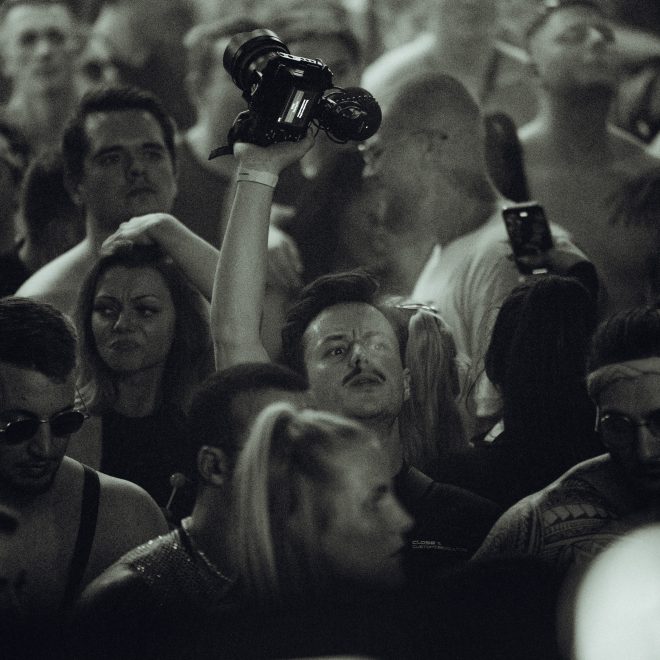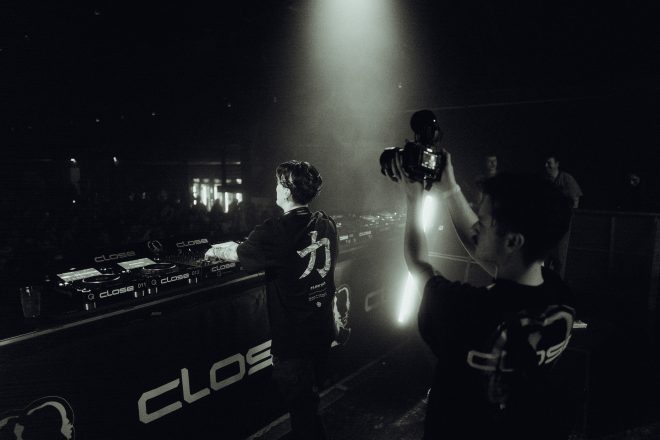Arrogantwerpen
Videography in rave culture : an exploration with Robin De Cock (arrogantwerpen)

In the past decade, the rise of social media has revolutionized how rave culture, particularly within the techno and hard techno scene, is experienced and shared. Videography, especially in the hands of professionals like Robin De Cock, better known by his moniker arrogantwerpen, has reshaped the way ravers and fans engage with these events. But as Robin points out, the role of videographers in this space is both celebrated and critiqued.
On one hand, videography has undeniably elevated the
reach of techno and rave culture. Platforms like Instagram and TikTok have become instrumental in giving
ravers a way to relive unforgettable nights. Robin notes that,
“The rise of platforms like Instagram has really expanded the scale of the scene. A well-crafted video can
make the energy of an event accessible to someone
sitting at home, miles away from the rave.”
Emerging artists now have a way to build their fanbase
long before they even take the stage, and for festivals
and clubs, visual content helps generate excitement
and a wider audience.
However, Robin acknowledges the downsides:
“We’re seeing a shift where some of the intimacy and subtlety of raving is lost in translation. DJs are becoming rockstars, and that puts the focus on the artist’s presence rather than the music.”
He touches on the phenomenon of the “sea of iPhones,” where attendees, more interested in capturing content for social media, are missing out on being fully present.
“You see people recording the best drops or transitions instead of dancing to them. For those of us who’ve been in the scene a while, that’s a shame,” he adds.
For Robin, balancing these dynamics while staying true to the authentic rave spirit is key to his work as a videographer. When asked how he visually represents the energy and emotion of a techno event, he explains,
“Every video I shoot tells a micro-story. It’s not just about capturing a DJ or a crowd—it’s about creating a visual narrative where all these elements come together: the music, the lights, the architecture, the people.”
His work aims to communicate the visceral experience
of connection and community that raves foster, ensuring viewers feel like they’re part of the moment even
if they weren’t physically present.

Robin elaborates on his technique:
“If the DJ is playing hard, intense tracks, I’ll go handheld with shaky movements and fast zooms to match the chaos. If it’s a groovier, more melodic set, I’ll use a gimbal for smooth, subtle movements that flow with the vibe.”
This approach highlights the duality in rave culture between darkness and light, chaos and harmony.
“Techno has always played with contrasts—there’s the raw, primal energy of the crowd against the more intimate, introspective moments,” he explains.
His color grading choices emphasize this duality as well.
“I use high contrast, sharpness, and rich colors to capture the energy. Each event has its own atmosphere, and color helps retell that vibe in a way that feels authentic.”
When it comes to the tension between authenticity and commercialization, Robin doesn’t shy away from acknowledging the shift.
“I don’t mind the conversation around the commercialization of techno,” he says.
“Look, I come from a dubstep and drum-and-bass background, and I’ve seen the transition from underground to mainstream before. Sure, there’s nostalgia for the more intimate days of raving, but we need to evolve. The scene is bigger, and that’s not necessarily a bad thing.”
For Robin, smaller venues are still where the magic happens.
“Large-scale events with big productions are impressive, no doubt, but they can feel a bit detached. The intimacy of a small club, with a 360-degree booth and the crowd right there with the DJ—that’s where I think the best footage happens.”
In terms of shaping the collective memory of rave culture, Robin sees videographers as essential to documenting this cultural moment, especially in a post-pandemic world.
“I always believe I am documenting a slice of history. After COVID, rave culture has exploded. People are coming back to these spaces after so long without human connection, and there’s a sense of liberation that comes with that. Capturing this freedom, connection, and love is an absolute privilege and a responsibility I take very seriously"
Behind the camera, Robin seeks to capture emotional states that feel raw and genuine.
“For me, it’s about honesty. I try to build a connection with both the DJ and the crowd. If they feel comfortable, they almost forget I’m there, and that’s when the real magic happens.”
Building rapport is key to his process.
“Spending time with the artist, getting into the crowd— these things help me blend in, and that’s where the most authentic moments come from,” he says.
Challenges are inevitable when filming live performances, but Robin remains unfazed.
“The biggest challenge right now is the number of phones in the crowd. Everyone’s filming for their Instagram, and while I get it, it can ruin a shot. I usually just politely ask them to pause, and there’s a lot of respect for what I’m trying to do, so people are pretty cool about it.”
In the end, Robin’s work is as much about collaboration and trust as it is about technical skill.
“It’s all about trust. When the artist trusts your vision, and you trust their music, something special happens.”
He reflects on his journey, crediting the French DJ SHLOMO with opening doors for him.
“SHLOMO was one of the first big artists to trust me with capturing his sets, and that experience shaped how I work today.”
Robin’s vision is shaped by his passion for telling stories visually, drawing inspiration from cinema to push the boundaries of how rave culture can be captured.
“I try to approach every video like a film scene. Every movement has a purpose, every shot tells part of the story,” he explains.
“There’s a fiction story I’m working on that’s been a passion project of mine for years. It’s a deep dive into identity and belonging, and I’m really excited about how it’s shaping up.”
For Robin, it’s all about finding the balance between capturing the intensity of the moment and honoring the quieter, more introspective moments that make rave culture so profound.
“It’s easy to focus on the chaos of a packed dancefloor, but some of the most beautiful moments come when things slow down, when friends are reconnecting, or when the DJ is lost in the music. That’s what I’m always looking for—those little moments of vulnerability.”
Robin’s ability to convey the visceral experience of a night out, through his innovative use of color, movement, and narrative-driven visuals, has redefined how raves are shared with a global audience. By balancing the hype of large-scale events with the intimacy of underground venues, he captures not only the music but the essence of community and connection that draws people to these spaces.
Through his lens, Robin documents more than just an
artist’s set; he captures a cultural moment, preserving
the ephemeral energy of each rave while shaping how
it’s remembered. As videography continues to play an
evolving role in rave culture, Robin remains at the forefront, guiding how the techno scene is visually represented in a time where social media and live experiences intertwine. His work, deeply rooted in authenticity,
continues to push the boundaries of what videography
can do for the world of electronic music, elevating it
into an art form that both honors the past and embraces the future.


